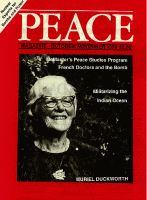
Peace Magazine Oct-Nov 1988, page 31. Some rights reserved.
Search for other articles by Isabelle George here
Search for other articles by Martin Zelig here
Search for other articles by Patra Dounoukos here
SASKATOON -- An end to uranium mining was the ultimate goal of participants at an International Congress on Uranium Mining in Saskatoon, Saskatchewan, June 16-21, 1988. Attending were government members, aboriginal people, physicians, geologists, journalists, scientists, and activists. They came from Australia, Belgium, Japan, Luxembourg, Switzerland, the United Sates, West Germany, and all parts of Canada. The main themes were problems experienced by aboriginal peoples, worldwide health and environmental effects, and ethics.
Seventy-one percent of uranium mining in the world is carried out on the lands of aboriginal people, but over which they have little control. Often their traditional way of life has been destroyed, so the promise of mining jobs is enticing. But Jeff Morin of Ile-a-la-Crosse, Saskatchewan, says that the only information they get about uranium mining is from the University. In workshops, instructors tell his people that everything is fine and that the water going back into Key Lake is pure.
International people told of living close to nuclear plants and test sites; of deaths due to leukemia and other cancers; of massive amounts of high-level radioactive waste that are piling up because no one know what to do with them; and of falsehoods and secret arrangements that pervade the whole nuclear industry.
In this regard, Senator Eric Gryp from Belgium, Jup Weber, M.P. from Luxembourg, and Lilo Wollny, Member of the Bundestag, FRG, told of the transnuclear scandal, which is having more negative effects on the nuclear industry than even Chernobyl.
This is because of the disclosure of bribes, irregular shipments and stockpiling of nuclear material, and clandestine transfers of nuclear technology and radioactive material to Pakistan. Disclosures of crime connected to the nuclear industry have led to the suicide of key employees.
Green Party members in Europe who exposed these irregularities believe that this is only the tip of the iceberg. Thus these Parliamentarians urged their Canadian colleagues not to be concerned merely with whether Canadian uranium is connected to weapons, but to know that the so-called peaceful use of nuclear energy is devastating our environment and lives. p
WINNIPEG -- The United States Air Force (USAF) has announced plans to base MX missiles on railway cars, a plan with dangerous implications for Canada. Eleven air force bases in nine American states are under consideration, particularly Grand Forks and Minot Air Force bases. Fifty MX missiles are currently being deployed in existing Minutemen silos in Western states.
Rail garrison would involve 25 trains carrying two MX missiles, possibly twice that amount. Although the U.S. hasn't announced plans to bring the missiles into Canada, the very real possibly remains that the MX would move across the border during the confusion of an international incident.
Last August, the USAF held hearings about the MX rail garrison proposal, mediated by Colonel Mike McShane, a U.S. military tribunal judge.
The meeting began with a talk by a Pentagon expert, Lt. Col. Walsh. He discussed the history of MX policy, and the controversial Draft Environmental Impact Statement (DEIS), a document detailing the potential impact of rail garrison on the local economy.
The report originated from an earlier set of hearings and from studies conducted by a private research company hired by the U.S. military, Tetra-tech. Tetra-Tech was once a Honeywell subsidiary. Speakers from the audience were given a three-minute limit. Comments were addressed to a panel, made up of: two airforce officers; a Tetra Tech representative; a pentagon expert, the formerly mentioned Lt. Col. Walsh; and a Pentagon scientist.
Also given speaking privileges were: the Mayor of Grand Forks; two city coucillors; two state legislators; mayors from surrounding communities; and Chamber of Commerce representatives. They generally praised the proposal and said they hoped it would be based in North Dakota. Many speakers fell back on the "good for the economy" rhetoric. Supporters outnumbered opponents by 31 to 19.
One of the most eloquent arguments against the plan was given by the executive administrator for the Centre of Peace Studies at the University of North Dakota. Kristen Sorenson put it simply: " It is nonsense to claim we must add 50 MX missiles, carrying 500 nuclear warheads to our arsenal of more than 13,000 long-range nuclear weapons in order to deter the Soviet Union from attacking vulnerable land-based missiles. We have a clear choice. We can build costly mobile MX missiles that will accelerate the arms race, or we can stop the arms race by negotiating verifiable agreements with theSoviets."
The final Congressional vote is in March 1989. Opponents, including those on Capital Hill are working to ensure its derailment.
BY PATRA DOUNOUKOS
VANCOUVER-- Veteran peace walker Derek Youngs and a B.C. family are on a one-year walk across Canada. The group, which includes two young children had reached Hamilton by Sept. 10, expecting to reach Sault Ste. Marie by October 24, Atikokan by Nov. 8, Sioux Narrows by Nov. 23, and Kenora by Nov. 28. Activists who wish to offer hospitality to these travelers can contact them through "Peace Wave Canada," Box 33825, Station D, Vancouver V6J 4L6. Phone 604/ 732-9168.

Peace Magazine Oct-Nov 1988, page 31. Some rights reserved.
Search for other articles by Isabelle George here
Search for other articles by Martin Zelig here
Search for other articles by Patra Dounoukos here